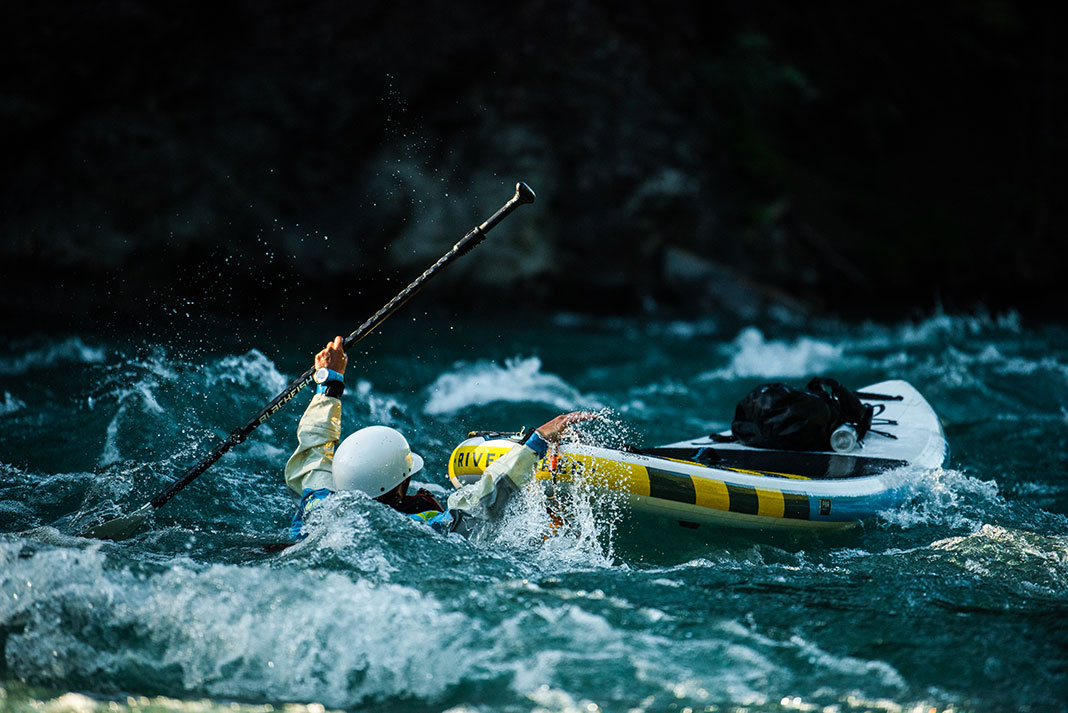Products You May Like
ASUP leash is a plastic cord connecting paddleboard to paddler. It’s an essential piece of safety equipment for flatwater paddling and ocean surfing, ensuring the paddler doesn’t become separated from their board in an upset. However, using a leash in the river environment is a contentious topic.
That’s because any line in moving water is an entrapment hazard. If a leash catches on a rock or strainer, even a relatively minimal current can anchor a paddler underwater. American Whitewater’s accident database reports seven board-related fatalities on moving water in the U.S. within the past five years. Of those, four involved leashes. Anecdotally, there are many more near misses.
SUP leashes on the river—yea or nay?
“Avoiding entrapment is a key concept for whitewater paddling, and a long, dangling rope carries that risk, even when on a quick-release,” cautions Danny Peled, director of Boreal River Rescue. “There are a lot of times where river paddleboarders shouldn’t be wearing leashes, but they saw other people doing it, or it seems acceptable. There’s no other situation where whitewater paddlers would have a long, dangly thing hanging. In many cases, the risks outweigh the benefits.”
The ACA also takes a conservative approach to leash use in moving water. It recommends leashes might be appropriate on large-volume rivers with deep rapids and swift currents free of obstructions. A swiftwater safety course is the best way to get educated to judge the appropriateness of using a leash based on the river in question and its current conditions.
Those who use leashes on the river argue they’re potentially a lifeline, keeping a paddler connected to their gear and board—which is an additional flotation device—and that a leash allows the paddler to swim without worrying about board management. In some high flow situations or on remote trips, the risk of losing a board may also outweigh the risk of entrapment.
“I always wear a leash. I see value in using it, and I respect it and am aware of its dangers,” says Melanie Seiler, a SUP instructor, former state director for the American Canoe Association (ACA), and current executive director of Active Southern West Virginia. Seiler grew up on Appalachian whitewater and views leashes as essential gear allowing paddlers to quickly get back on their boards where they’re safest.
River versus flatwater SUP leash usage
When using a leash on the river, it should never be attached to the ankle or leg, as is typical in flatwater SUP. This is because it may be impossible for the paddler to bend against the current and reach upstream to release the leash in an entrapment scenario. A leash used in moving water must instead be attached at or above the waist, reachable by both hands, and on a quick-release system. Coiled leashes are preferred for river use to keep the leash out of the water and prevent snagging.
Seiler encourages regular practice with the quick-release system for extreme situations. “There has to become some muscle memory to make it happen in a situation it’s designed for: You’re in rushing water and pinned. Your eyes are closed, and your hand is finding the release mechanism and feeling how hard you have to pull it and in what direction to get it to come loose. All at a time you’d be freaking out.”
There are also a few circumstances where Seiler doesn’t promote leashes, such as when she teaches beginner classes on flat rivers, or when the leash poses a significant risk of entanglement with others, as at mass start races.
Auto-fail points can save you in a pinch
Standup paddleboarding isn’t the only board sport making its way from the coast to interior whitewater over the past decade. River surfing continues to gain popularity, especially as stationary waves take shape in outdoor towns globally. The risks of leashes are also discussed in the fledgling river surf community, according to Neil Egsgard, president of the Alberta River Surfing Association and founder of the Calgary-based stationary wave design firm, Surf Anywhere.
At the waves Surf Anywhere has designed, Egsgard’s company places signage reading: “Danger. All leashes can drown river surfers. Current will not let go. Surfer cannot release. Do not wear a leash or do have a leash auto-fail point at the body.”
“A common misconception is [quick-release] leashes are always releasable,” says Egsgard. “Taking a whitewater safety course with professionals quickly reveals releasing leashes under tension can be very challenging.”
Egsgard argues manual quick-release systems can fail and recommends river surfers and paddleboarders wear leashes with an auto-fail point. This component, such as a low-strength cord or a plastic strap, is manufactured to break under tension. If a paddler becomes trapped and cannot activate their quick release, this component will break and the paddler will float free.
To leash or not to leash?
Ultimately, there’s no one correct answer to the question of leashes on the river. Safety equipment needs to be tailored to the specific river environment and it’s each paddler’s responsibility to get the education to make informed decisions about where a leash is appropriate.
This article was first published in the Early Summer 2022 issue of Paddling Magazine. Subscribe to Paddling Magazine’s print and digital editions, or browse the archives.
To leash or not to leash? Either way, river paddleboarders also need to wear all the essentials of whitewater paddling, including helmet and inherently buoyant PFD. | Feature photo: Ashley Voykin
